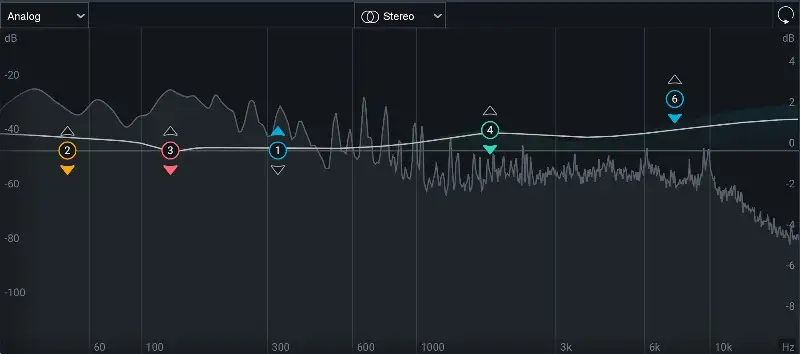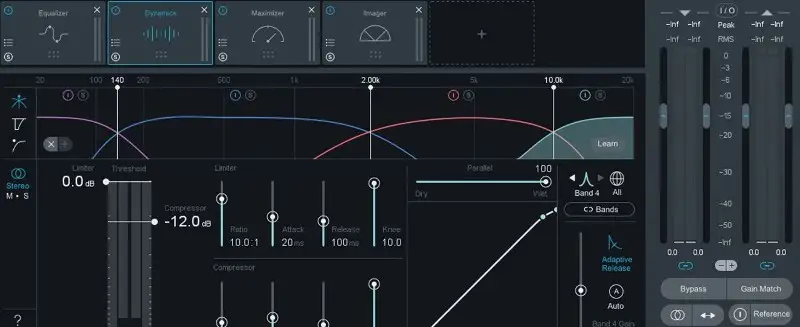Two of my favorite tools for mixing and mastering are dynamic EQ and multiband compression.
Both of them operate in a similar way, offering dynamic control for specific frequency ranges with EQ-like functionality that allows you to adjust the overall tonal balance of the audio signal you're processing. I find them incredibly helpful when I'm dealing with problematic imbalances in my mixes, as they can act with transparency and respond to the source material better than traditional EQs and compressors.
However, though they might share many similarities, there are a few differences that are important to note when choosing to use one or the other.
In this short guide, we'll take a look at the differences between multiband compression and dynamic EQ and explore situations in which one might be the better option.
However, before we dive in and explore what makes them different, let's make sure you understand what each one does in the first place.
What is Dynamic EQ?

Dynamic EQ provides all of the precision of a parametric EQ with the adaptive personality of a compressor, allowing you to adjust the volume of individual frequencies or groups of frequencies and get your EQ to react to changes in the frequency spectrum as they occur.
So, how does this work?
Essentially, you apply boosts or cuts like you normally would with an EQ. However, rather than the band you use working statically, it will respond to the input signal as it crosses over a set threshold.
Let's say you have a band with a frequency point at 3kHz and you want it to attenuate the incoming signal, though only when that 3kHz frequency becomes too prominent. You could set the threshold so that it only attenuates a chosen dB level whenever the 3kHz region in your incoming signal goes above that threshold.
When to Use Dynamic EQ
There are several instances in which dynamic EQ takes the cake over static EQ. Some of the most common reasons to use dynamic EQ include:
- Taming low-end rumble in an instrument or mix
- Taming harsh frequencies in vocals
- Dipping certain frequencies to get them out of the way of a sidechain source
What is Multiband Compression?

With multiband compression, the incoming signal is split into several defined bands. Many multiband compressors split the frequency spectrum into four bands, though others allow for more.
In-between the splits, we have crossover filters, which are where the high- and low-pass filters of neighboring bands intersect with one another. The pole numbers or slopes of the high- and low-pass filters provide constant amplitude through the crossover points, keeping the frequencies of the incoming signal near those points unaffected (for the most part).
Within each band, you'll find standard compressor controls, including attack, release, threshold, ratio, knee, and makeup gain. These parameters work just as you'd expect.
When the signal within a single band crosses over that band's threshold, it'll attenuate or compress everything in-between the two crossover points. Each band is then combined at the output signal.
When to Use Multiband Compression
Multiband compression can be very helpful in instances where you need control over a certain frequency band in an input signal without impacting the overall signal. A few of the most common reasons you might use a multiband compressor include:
- Controlling low frequencies in a bass
- Reducing sibilance in a vocal
- Balancing the dynamics across an entire mix
What's the Difference Between a Dynamic EQ and Multiband Compressor?
Multiband compressors split the incoming audio into numerous wide bands across the frequency spectrum before applying any compression. As the incoming signal crosses the threshold of a single band, the multiband compressor will apply changes evenly across it.
It's also worth noting that multiband compression introduces very subtle phase shift or distortion artifacts from splitting and re-joining numerous bands together. Even though digital filters are much higher quality than they were a decade ago, these nuances still exist, so much so that they can introduce small time delays, which can lead to further phasing issues or comb filtering.
Of course, there are some multiband compressors that use linear phase filters, addressing the issue of phase shift so that it doesn't color the signal too much. Some of my favorite ones include the FabFilter Pro-MB and the Waves Linear Phase Multiband Compressor .
Dynamic EQ is different in that it does not split the incoming audio signal into different frequency ranges or bands as a default. By simply passing a signal through a dynamic EQ plugin, you won't change the characteristic of the sound in any way. You can also act with much more precision using a dynamic EQ compared to most multiband compressors, allowing for better surgical work without as many artifacts.
At this point, you might thinking, "Wait a minute, doesn't EQ introduce phase shift as well?" Well, you're 100% right. However, with dynamic EQ, it doesn't occur until the bands engage, meaning the rate of artifacts ends up being much lower.
Character
One of the other reasons that multiband compression sounds different than dynamic EQ is that it works using ratio, rather than focusing purely on level or gain. Compression that is driven by a ratio will have a distinct sound compared to the transparent results you get from a simple level boost or cut.
In the end, if you want a more sterile or surgical sound, I'd recommend reaching for a dynamic EQ instead.
Number of Bands
Some of the most popular multiband compressors have anywhere from four to six bands, each of which covers numerous frequencies between the crossover filters. On the other hand, dynamic EQs typically have more bands available for use. Some, such as the one from FabFilter, allows you to insert brand new bands, which you can make as wide or narrow as you need.
Using Dynamic EQ and Multiband Compression Together
Though they certainly have their own unique strengths and setbacks, there's no reason why you can't use them in tandem to take complete control over your audio signal. I love how surgical dynamic EQs are, as well as how versatile multiband compressors are.
I often find myself using these two tools on vocals. For example, I might use a multiband compressor to even out the overall sound of my vocal and get rid of nasty sibilance before coming in with a dynamic EQ to tame resonances or harsh frequencies In the end, you get the best of both worlds.
Specific Scenarios Where These Tools Might be Useful
Dealing with Low-End Buildup
If you're dealing with buildup in the lower frequencies that only occurs every once in a while, I'd recommend reaching for a dynamic EQ. This can be any instrument, not just bass or kick. You might have vocals, acoustic guitars, electric guitars, or keys that have excessive low-end content you want to get rid of to make more room for other instruments in your mix.
Though multiband compression is the "OG" tool for this kind of issue, I feel like dynamic EQs provide greater transparency. All you have to do is search for the problematic range and engage a dynamic EQ to work when the low-end passes above the set threshold.
Unless there is a very specific note that is giving you a problem, I'd recommend using a wide Q value for a cleaner, more natural sound.
Uneven Bass
While I'm a huge fan of dynamic EQ overall, when it comes to dealing with uneven bass, multiband compression has been my go-to.
Once in a while, I'll receive a bass recording from an inexperienced player who didn't play all of the notes on their bass at the same level. If there are certain notes sticking out, you can attack them surgically with a dynamic EQ. However, if the low notes are all over the place and you need some more general control, a multiband compressor can be your saving grace.
When I need to lock in the low-end on a bass guitar, I'll usually set my multiband compressor up with a low frequency band from 0-150Hz, with a fast attack, medium release, and 4:1 ratio. Then, I'll set the threshold pretty low so that it locks in a consistent volume in that range of the audio signal. It's been a go-to trick of mine for ages, and I can't think of the last bass guitar I mixed without it.
Sniping Vocal Resonance
You might have a vocal performance that changes drastically throughout the track. For example, the singer might be quiet and whispery during the verse, though when they start belting in the chorus, you're left with harsh frequencies in the upper mids that jump out at you.
I typically start by arming myself with a dynamic EQ that is honed in on the problematic frequency. If it's feeling nasal, I'll look in the 1.5-2kHz range, though if there's some tinny harshness, I'll shoot higher around 4kHz. The beauty of dynamic EQ is that it'll only attenuate these frequency bands when they become an issue, keeping your vocal feeling present and forward when they're not.
Final Thoughts
Even with all of this said, there aren't any hard and fast rules about when to use one over the other. Also, it's worth noting that some dynamic EQs don't provide as much transparency as certain multiband compressors. Take the BSS DPR-901 II, which is a prime example of an analog dynamic EQ that has some serious color.
However, with a general understanding of the differences between these two tools, you'll feel more comfortable choosing the right one for your particular task.
The main takeaway is that though you may be able to get similar results with either, they are fundamentally different by design. Of course, I wouldn't let that stop you from experimenting with either in any given situation to see what sounds better. The results might surprise you!





